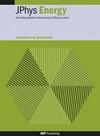Effect of Zn(TFSI)2 on the performance-aging time of perovskite solar cells
IF 6.3
3区 材料科学
Q1 ENERGY & FUELS
引用次数: 0
Abstract
Hole transport layers (HTLs) are one of the essential layers of perovskite solar cells (PSCs). Generally, 2,2ʹ,7,7ʹ-Tetrakis [N,N-di(4-methoxyphenyl)amino]-9,9ʹ-spirobifluorene (spiro-MeOTAD) doped by lithium bis(trifluoromethanesulfonyl)imide (LiTFSI) is used as the HTL in PSCs. PSCs employing spiro-MeOTAD require an additional aging process to reach an optimized point of photovoltaic performance due to doping and energy alignment. However, LiTFSI is responsible for low thermal stability and has a hygroscopic nature; therefore, Zinc(II) bis(trifluoromethanesulfonyl)imide (Zn(TFSI)2) has been reported as an outstanding candidate to replace LiTFSI. Nevertheless, utilization of Zn(TFSI)2 as a dopant for PSCs has rarely been reported, which is likely due to the difficulty in achieving high device performances comparable to that with LiTFSI. Herein, we investigate the effect of Zn(TFSI)2 on the doping kinetics of spiro-MeOTAD and correlate it with the time-dependent photovoltaic performance of PSCs employing Zn(TFSI)2. Devices with Zn(TFSI)2 require a considerably longer aging time (∼270 h) to reach the optimized performance, while LiTFSI takes only ∼20 h due to the different doping kinetics of spiro-MeOTAD depending on the dopant. Remarkably, engineering at the interface of the perovskite/HTL can effectively shorten the device aging time by manipulating the recombination rate, leading to a comparable aging time to LiTFSI.Zn(TFSI)2对钙钛矿太阳能电池性能老化时间的影响
空穴传输层(HTL)是钙钛矿太阳能电池(PSC)的重要层之一。通常,由双(三氟甲磺酰基)酰亚胺锂(LiTFSI)掺杂的2,2,7,7-四[N,N-二(4-甲氧基苯基)氨基]-9,9-螺二芴(spiro-MeOTAD)用作PSCs中的HTL。由于掺杂和能量对准,采用螺MeOTAD的PSC需要额外的老化过程来达到光伏性能的优化点。然而,LiTFSI的热稳定性低,并且具有吸湿性;因此,锌(II)双(三氟甲磺酰基)酰亚胺(Zn(TFSI)2)已被报道为取代LiTFSI的杰出候选者。然而,很少报道使用Zn(TFSI)2作为PSC的掺杂剂,这可能是由于难以实现与LiTFSI相当的高器件性能。在此,我们研究了Zn(TFSI)2对螺MeOTAD掺杂动力学的影响,并将其与使用Zn(TFSI)2的PSCs的时间依赖光伏性能相关联。具有Zn(TFSI)2的器件需要相当长的老化时间(~270 h)才能达到优化的性能,而LiTFSI只需要~20 h,这是由于螺MeOTAD的掺杂动力学不同,取决于掺杂剂。值得注意的是,在钙钛矿/HTL界面进行工程可以通过控制复合速率有效缩短器件老化时间,从而获得与LiTFSI相当的老化时间。
本文章由计算机程序翻译,如有差异,请以英文原文为准。
求助全文
约1分钟内获得全文
求助全文
来源期刊

Journal of Physics-Energy
Multiple-
CiteScore
10.90
自引率
1.40%
发文量
58
期刊介绍:
The Journal of Physics-Energy is an interdisciplinary and fully open-access publication dedicated to setting the agenda for the identification and dissemination of the most exciting and significant advancements in all realms of energy-related research. Committed to the principles of open science, JPhys Energy is designed to maximize the exchange of knowledge between both established and emerging communities, thereby fostering a collaborative and inclusive environment for the advancement of energy research.
 求助内容:
求助内容: 应助结果提醒方式:
应助结果提醒方式:


